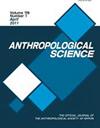日本神奈川县崇吉贝壳堆遗址出土的人类骨骼的线粒体DNA分析
IF 0.8
4区 社会学
Q3 EVOLUTIONARY BIOLOGY
引用次数: 6
摘要
最近的研究表明,绳纹人在基因上与其他任何民族都有很大的不同,包括现代日本人。这就产生了一个有趣的问题:在绳纹时代之后,这种基因特征的剧烈变化是什么时候发生的?位于日本神奈川县的正义寺炮弹堆遗址可以为解决这个问题提供一些线索。在这个地点埋葬的骨骼中,有一些比几乎与他们一起被埋葬的约蒙时代的骨骼更晚。通过线粒体DNA (mtDNA)的分析,对正吉壳人的遗传连续性进行了检验。我们的研究结果表明,古坟和平安时代骨骼的mtDNA单倍群与绳纹骨骼的mtDNA单倍群存在巨大差异。这一发现表明,日本人的基因转换可能发生在古坟时代或之前,至少在正友寺遗址是这样。为了证实这一假设,对正友司人的核基因组分析被认为是有希望的。本文章由计算机程序翻译,如有差异,请以英文原文为准。
Mitochondrial DNA analysis of the human skeletons excavated from the Shomyoji shell midden site, Kanagawa, Japan
Recent studies have revealed that the Jomon people are considerably genetically different from any other population, including modern-day Japanese. This gives rise to an intriguing question: when after the Jomon era did this drastic change of genetic features occur? The Shomyoji shell midden site in Kanagawa, Japan can provide some clues to address this question. The skeletons buried at this site include some that are more recent than the Jomon-era skeletons with whom they are almost contiguous-ly buried. We tested the genetic continuity of the Shomyoji shell midden people by analyzing mitochondrial DNA (mtDNA). Our results show that the mtDNA haplogroups of the Kofun and Heian skeletons vastly differ from those of the Jomon skeletons. This finding implies that the genetic conversion of the Japanese people may have occurred during or before the Kofun era, at least at the Shomyoji site. To confirm this hypothesis, nuclear genome analysis of the Shomyoji people is considered promising.
求助全文
通过发布文献求助,成功后即可免费获取论文全文。
去求助
来源期刊

Anthropological Science
生物-进化生物学
CiteScore
1.50
自引率
0.00%
发文量
7
审稿时长
>12 weeks
期刊介绍:
Anthropological Science (AS) publishes research papers, review articles, brief communications, and material reports in physical anthropology and related disciplines. The scope of AS encompasses all aspects of human and primate evolution and variation. We welcome research papers in molecular and morphological variation and evolution, genetics and population biology, growth and development, biomechanics, anatomy and physiology, ecology and behavioral biology, osteoarcheology and prehistory, and other disciplines relating to the understanding of human evolution and the biology of the human condition.
 求助内容:
求助内容: 应助结果提醒方式:
应助结果提醒方式:


